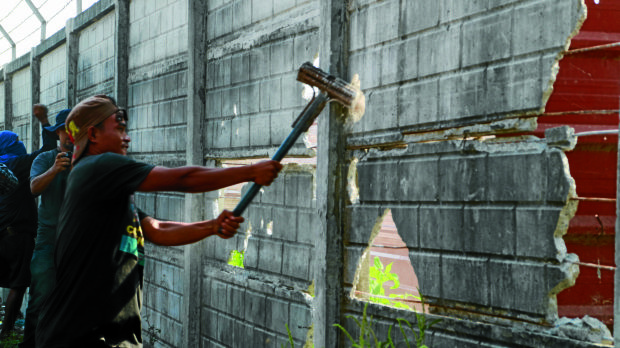
FORCIBLE ENTRY Farmworkers tear down the concrete fence put up by Rizal Commercial Banking Corp. in an attempt to gain entry to 500 hectares bought by the bank from the Cojuangcos in Hacienda Luisita in Tarlac province. —CONTRIBUTED PHOTO
CITY OF SAN FERNANDO—In so many ways, the Comprehensive Agrarian Reform Program (CARP) may have failed in Hacienda Luisita, as the majority of the beneficiaries have either leased, mortgaged or sold their lots despite a ban on the transfer and sale of these for 10 years, a validation by the Department of Agrarian Reform (DAR) between March 6 and April 7 showed.
CARP was the centerpiece program of the first Aquino administration.
Many beneficiaries said they were not aware of the ban on leasing or selling CARP lands. They leased or sold their lots to support sick family members or to buy seeds and tools.
Covering 5,031 of 6,212 beneficiaries in 10 villages inside the estate, the validation showed that 2,800 farm workers leased or mortgaged their lands, 600 sold their lots to third-party buyers and 200 took part in joint venture agreements in spite of a condition that these properties must not be transferred or sold for 10 years.
The culprits were “local politicians or ‘arriendador’ (renters),” Agrarian Reform Secretary Rafael Mariano said on Tuesday. “They were not in possession of the awarded lands,” he added.
Under the “arriendo” scheme, sugar planters rent land from agrarian reform beneficiaries.
The agrarian reform beneficiaries’ lack of control over the land was why the Supreme Court, in its Nov. 22, 2011, resolution, canceled the stock distribution option (SDO) in Hacienda Luisita.
Day after occupation
Mariano released the results of the validation a day after his former group, the Kilusang Magbubukid ng Pilipinas (KMP), took over the property of Rizal Commercial Banking Corp. (RCBC) in Barangay Balete on the Tarlac City side of the estate.
The validation team was headed by Marcos Risonar Jr., agrarian reform undersecretary for field operations and Luisita Task Force chair, and Elmer Distor, agrarian reform assistant secretary for legal affairs.
From just dispensing shares of stock to farm workers in 1989, CARP in the vast sugar estate owned by the clan of former Presidents Corazon Aquino and Benigno Aquino III took the form of compulsory acquisition at a cost of P471.5 million.
This was after the Supreme Court on April 24, 2012, upheld the 2005 decision of the Presidential Agrarian Reform Council to cancel the SDO in the 6,453-hectare estate in Tarlac province.
Cojuangco property
Corazon Aquino’s father, Jose Cojuangco Sr., bought Hacienda Luisita from its Spanish owner in 1957. It was during Aquino’s term as president when she signed CARP into law.
By January 2014, the DAR had given 6,600 square meters to each of the 6,212 farm workers from out of the 4,500 ha ordered distributed by the Supreme Court, or what were left after the sale of 500 ha to RCBC and 81 ha to the Bases Conversion and Development Authority for the Luisita interchange of the Subic-Clark-Tarlac Expressway.
Renting out lands was widespread in Barangays Mabilog and Pando in Concepcion town and in Barangay Motrico in La Paz town, both in Tarlac.
More lots were sold in Barangays Cutcut ll and Mapalacsiao in Tarlac City. Only a few—117 of 236 beneficiaries in Barangay Bantog in Tarlac City—grew vegetables, rice and corn.
“DAR recognizes the sacrifices and efforts of the farmers who remained in possession of their awarded lands. This is also to honor and give justice to the families of victims of Hacienda Luisita massacre, as the Cojuangco and Aquino families continue to maneuver to circumvent the SC decision,” Mariano said.
He was referring to seven workers who were killed in 2004 when soldiers and policemen retook the gate of the Luisita sugar mill during a strike.
Mariano urged those who rented out their lots or sold these to hold ground in their awarded lands because the exacerbation of the arriendo system in Luisita was, he said, a “deliberate obstruction of the delivery of agrarian reform.”